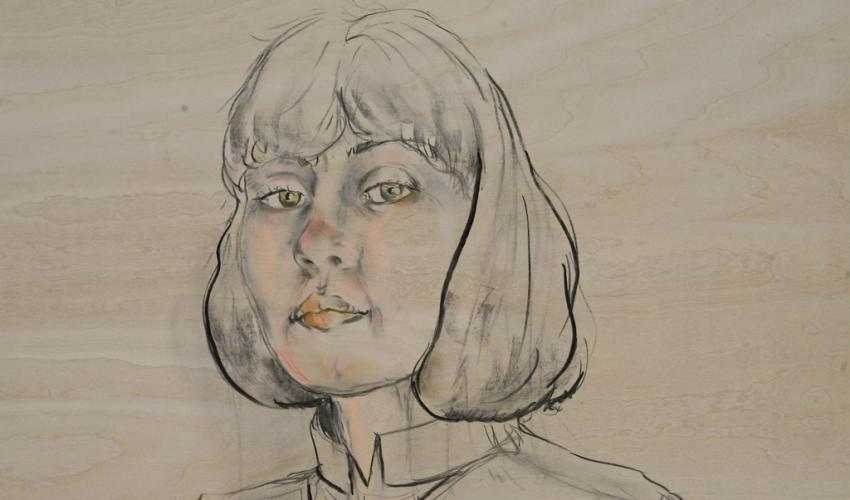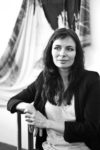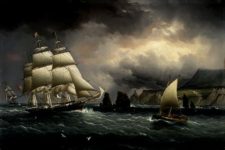

April Street
American, 1975-
The Mariners' Grand Staircase (Armoured Stars and Flying Clouds), 2018
mixed media

April Street in her Los Angeles studio June 2013.
“I went through a lot of change in my approach to making art for myself. To be honest, I became confident in my voice again, and when I asked myself, 'What ... am I doing this for?' - this work became my answer to that.” - April Street
POSTSCRIPT
When the California gold rush began in 1848, it typically took a sailing vessel from the U.S. East Coast at least half a year to make the voyage around Cape Horn and up the western coast of South America. Rabid treasure hunters were willing to invest all their money to make the fastest time. New England clipper ships were the swiftest carriers. They competed to decrease the coast-to-coast time...
Ninety-six days was the current record time from New York to San Francisco, set by the clipper Surprise, when the Flying Cloud began its maiden voyage from the East River early on the afternoon of 2 June 1851. Its commander was savvy, seasoned Capt. Josiah P. Creesy...
Capt. Creesy had been chosen as the Flying Cloud’s skipper because of his reputation for getting the most from his crews. He proved worthy of the owners’ trust even in this situation. Despite ominous grumblings, severe gales, broken rigging and snowstorms off Cape Horn, he steadily worked the Cloud to its destination. Its speed at moments topped 18 knots – unprecedented in the era of sail. It would be years before even a steamship equaled some of its daily times. The Flying Cloud docked at San Francisco on 31 August after a record-setting epic, three hours under 89 days.
Much of the credit for the ships stunning feat was due to its navigator: Eleanor Creesy, wife of the captain. Mrs. Creesy, a native of Marblehead, Massachusetts, had studied ocean currents, astronomical navigation and nautical weather patterns since her youth. She demonstrated her skill in vital fashion as the Flying Cloud found its way around notorious Cape Horn. In one instance, with visibility too murky to see far ahead, she advised the captain to shift course. According to her dead reckoning, they were fast approaching a rocky land point indicated on the charts. As it proved, her calculations were precisely accurate.
Two yars later, the clipper shortened its own time for the east-to-west coast journey by 13 hours. The Flying Cloud’s 1853 record was not bested until 1989, as modern racing yachts equipped with state-of-the-art technology pursued their own brand of New York-to-San Francisco “challenge.”
- The Sensational Voyage of the “Flying Cloud”, World History, May 21, 2017
https://worldhistory.us/american-history/the-sensational-voyage-of-the-flying-cloud.php

The Clipper Ship "Flying Cloud" off the Needles, Isle of Wight, 1859-1860 by James Buttersworth
COMMENTS
Interview with the Artist
There is a simple fact about art that is often forgotten these days— nothing beats the experience of actually standing in front of it, really being there with it. And some art, such as April’s, proves just how stirring a work can be when viewed up close and personal. I can’t remember exactly how, but Klea found April’s work early on in our research for the WESTERN EDGE trip. We oohed and awed while looking at her paintings online, staring at the flesh-like folds of fabric, the rich irregular smudges of color, and the unexpected sense of movement in her work. We wondered about the titles that seemed to tell a whole story in one brief sentence. We talked about the extended outlines of her paintings, and the gravitational push and pull of the fabric. We grew increasingly more excited and curious. We desperately hoped she would say yes to a studio visit. Lucky for us she did… because even as good as April’s work looks on her website, there was no way a computer screen could prepare me for how arresting it is in person. April was a bit of a surprise, too— based on her work, we had assumed she would be intense, maybe even dramatic. But instead she was giggly, and warm and spoke with an endearing Appalachian drawl. It’s a funny thing when the person behind the work is quite different than what you’d expect because it makes you remember how multifaceted we all are, and how certain aspects of our personalities or thoughts are often obscured or only channeled in distinct, singular ways.
April’s paintings are sculptural in nature, mostly consisting of twisted or draped hosiery fabric stretched and pinned across canvases. Occasionally, recognizable objects are placed under the fabric veils to create purposeful protrusions, and other paintings are sometimes spun into ropes ending in cast bronze knots or tied like nets and arranged to resemble bows and arrows. Almost all of the paintings begin with a performative act that no one is allowed to witness. April wraps herself in hosiery and moves across pools of paint on canvas, creating creases and smears of color while reenacting the positions her body has made while sleeping (which she records.)
The most compelling aspect of April’s work is that it’s fraught with high-stakes emotion. Her palette and draping technique reference the body and bring a physical tension to the work while simultaneously eliciting raw-edged feelings; a secret ache, anxiety, or awe comes creeping in and catches you off guard. A shared vulnerability is created between you and the painting, visceral reactions churn beneath the surface of your composure, and the swathes of smeared colors across the skin-like hosiery somehow resemble the mess of blood, guts, and bone that we all are. Like any other protective layer, the veils of fabric in April’s paintings simultaneously hide and reveal; by deliberately obscuring elements of the work, something very private and personal is both professed and acknowledged. Even if we can’t fully unravel the works’ secrets, we are clued in that they are there.
How would you describe your subject matter or the content of your work?
My current work is about a fictional familial construct within the idea of building a form as a stand in for emotive attachments between the paintings, objects, and a viewer. I invite complications. I make objects of action that acknowledge the identity shifts and role-play that occur when one takes their art from private to public, adapting to another stage.
The idea of labor and the hiding of it to posture oneself as part of a certain class or click is an interesting dilemma. My friend told me once that he wanted to go to the tanning bed before he went back to London in January because people would think he was rich and just got back from holiday. He thought it would also help him pick up a date, I love that… haha. My portraits hide the labor of the canvas painting, alluding to this idea of the individual who dresses herself/himself to blend into a different economic scene, higher or lower, to feed a particular social longing.
What mediums do you work with?
I use hosiery and acrylic paint, bathing suit lining, cast bronze, papier-mâché, and wood to evoke ideas of skin, duration, labor, and adaptation. My process begins with a performative act you aren’t allowed to witness. I wrap myself in hosiery materials to enact a series of body positions (which I record while I sleep) into pools of paint on canvas. The impression made by this act is rinsed away while the paint is still wet and then the memory of the gesture is repainted. The result is intuitive mark making to describe my ideal fantasy of what happened in the original. What begins with a private performance ends with the psychological construction of public portrait. Posturing, social awkwardness, and sexual identity are all tied up in the paintings’ reactions to each other.
We all have these personal histories that we don’t always readily offer to each other, and when you are in public or meet new people you decide how much to give. Similarly my work takes on aspects of the private and public— the initial performative act done behind closed doors creates a history that adds to each piece and it doesn’t matter that a viewer knows the specifics of it. A lot of the time and labor that goes into the work isn’t necessarily made obvious, instead it’s often purposely concealed. My paintings deal with this suspension of disbelief, they extend from eccentric abstraction to explore portraiture through hosiery, paint, and process.
Your draping technique and use of hosiery has been a fairly recent development in your work— what prompted that shift?
A lot of things coincided for me in the lead up to my new work and the hosiery pieces; I had a major personal loss in 2009. Through this period of mourning I was questioning everything around me and eventually I woke up… I went through a lot of change in my approach to making art for myself. To be honest, I became confident in my voice again, and when I asked myself, What the fuck am I doing this for?— this work became my answer to that.
Also during this time, 2011, I had a show Rosamund Felsen Gallery. The paintings in this show brought out a preoccupation I had with proximity of an artist to a work. I was questioning how deep can you get into it like a method actor, and whether through a process you can create an energy that could live inside the work afterwards when the process is over. So here I began to use my body to move paint around the canvas. I wanted this work to be made in this physically difficult and intimate way but look mechanically made, almost photographic. I was also interested in the way I grew up looking at nature up close in the Appalachian Mountains as opposed to seeing it at a distance in the expanse of the West. In the end, this work was really my homage to the light and space movement in LA and Rosamund’s history with LA art. I was especially looking at Paul McCarthy’s early action/Gutai inspired work at that time because of his affiliation with her gallery.
After that show, is when I started diving into the gestures becoming portraits and the relationships that are built between each individual painting as one idea is the offspring of another in the studio. I think of the hosiery as both the author of the gestures but also when I put it back on top of paintings it is like a protective covering that readies the paintings for the public. Using the hosiery as a stand in for skin and also using it and my body as the brushes that make the paint gestures seemed natural and progressed towards the psychologically charged role play I began in my first show with Carter & Citizen, Portraits and Ropes in 2012. The ropes (spun paintings) and mechanisms for defense (gold leaf bow and arrow and nets) came next.
The materials you employ and manipulate hint at the deep intimacy of familial and romantic relationships, but tension is present too— can you tell us more about this interplay?
I began as a sculptor and a figurative painter, I have love/hate relationships with painting and that provides its own kind of tension. I use beauty and romantic attachments in my work because I want to be in that fully, but reality always knifes you just a little…so that is there too. I think a lot about fragility of human bonding.
What does having a physical space to make art in mean for your process, and how do you make your space work for you?
I am a studio artist and process based. I go to work everyday there. My dad is a coal miner and my mother a nurse and they gave me a strong work ethic. I would rather work in my studio than be on vacation.
Do you see your work as relating to any current movement or direction in visual art or culture?
There is such a cultural discontent with the body— why can’t it last, this will make it look better, stop aging, this pill will erase what hurts, this advertisement will make it eat more, that is my image of perfection…I also feel a lot of artists, like myself, are interested right now in labor and craft in opposition to everything being mass manufactured. I don’t want a large disconnect between the maker and the object, I want there to be an intimate exchange between myself, my work, and a viewer.
We all have a common current of economic uncertainty and dissatisfaction with time to deal with, it’s hard to find an individual voice when things seem too large to manage. I feel that when everything around me is chaotic, my own physicality becomes my most important instrument for change.
An exploration and deconstruction of the picture plane, using stand-ins for the body to evoke a psychological marker in time is a common thread with many other artists in LA right now.
Which other artists might your work be in conversation with?
Simon Starling, Marc Camille Chaimowicz, Eva Hesse, of course… There are too many LA artists who inspire me and who are also my friends so I won’t get too into that in order not to leave anyone out. I just got turned on to Markus Schinwald‘s leg pieces and I’m in love with those right now.
Although it is probably not obvious in my work, I am influenced by the pictures generation, Jack Goldstein and Sarah Charlesworth. I don’t work with the image in the way they did, but I think that way within the realm of what I am doing with my painting. The ideas of peeling away at an advertisement and the emotional trickery used in them to make us desire, especially the use of sexuality to provoke connections is something I am conscious of in making visual work. In the studio right now with the new armature/skin on skin pieces there are more obvious underlying elements of these tricks. I am interested in the psychological workings of being an artist and dealing with this overwhelming visual culture, just in LA, in this moment. How can I give form to an action and a psychological state that is constantly changing? Imagery moves in and out of us so fast with the Internet… we have that to deal with as image makers.
http://inthemake.com/april-street/
SBMA CURATORIAL LABELS
"The Mariners’ Grand Staircase (Armoured Stars and Flying Clouds)" is inspired by Eleanor Creesy and her historic voyage on the great clipper ship the "Flying Cloud". As the ship’s navigator, Eleanor Creesy held an unusual position for a 19th century woman of her time. She became instantly famous on August 31, 1851, after sailing from New York to San Francisco in only 89 days - less than half the time the voyage usually took. Her husband, Josiah Perkins Creesy Jr., was the ship’s captain.
Comprised of twelve fabric relief paintings and charcoal drawings, Street's multimedia installation reimagines the Museum's Park Entrance staircase as the grand staircase in the Creesy home. The accompanying sound conjures a fictional conversation between the navigator and her sea captain husband as they ascend the stairs at day‘s end. The dialogue, constructed by the artist with inspiration from famous novels about the sea, proceeds forward but also circles back as the couple eventually repeats each other’s lines. The artist's envisage of the seafaring couple, their setting and exchange provokes subtle shifts in sentiment and meaning, creating a new narrative that subverts time and place.
April Street's works combine the material experimentation of I960s-1970s feminist practice with allusions to the theatricality, illusionism, and palette of seventeenth-century Dutch still-life painting. She continuously repurposes her paintings with displaced objects, personal stories, and art historical references to ignite an interchange between the viewer and the works about representation, duration, and absence.
"The Mariners‘ Grand Staircase (Armoured Stars and Flying Clouds)" coincides with Street's residency at the Ridley-Tree Education Center at McCormick House and a series of interactive projects and environments designed by the artist, including "Deep Sky Objects made visible for Everyone", a corresponding installation in SBMA’s Family Resource Center (September 15, 2018 - February 17, 2019).
The installation marks the inauguration of Park Projects, a series of temporary installations utilizing the grand stairwell at SBMA's Park Entrance. Sited prominently at the Museum's main point of access during the ongoing renovation, this program features works by cutting edge contemporary artists that aim to add visual impact as well as opportunities for meaningful engagement.
"The Mariners' Grand Slaircase (Armored Stars and Flying Clouds)" appears at SBMA courtesy of the artist and Susanne Vielmetter Los Angeles Projects.
- Park Projects, August, 2018
